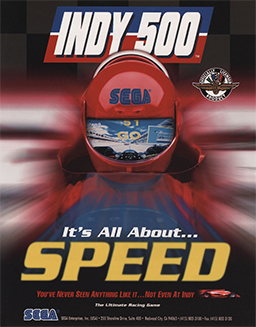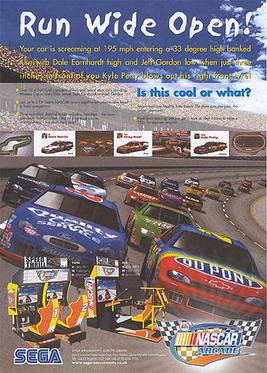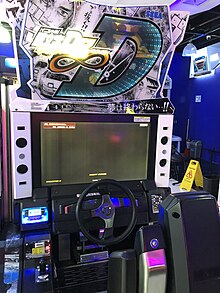Sonic Team is a video game developer owned by the Japanese video game company Sega as part of its Sega CS Research and Development No. 2 division. Sonic Team is best known for the long-running Sonic the Hedgehog series and games such as Nights into Dreams and Phantasy Star Online.

The Dreamcast is a home video game console released by Sega on November 27, 1998, in Japan; September 9, 1999, in North America; and October 14, 1999, in Europe. It was the first sixth-generation video game console, preceding Sony's PlayStation 2, Nintendo's GameCube, and Microsoft's Xbox. The Dreamcast was Sega's final console; its 2001 discontinuation ended the company's eighteen years in the console market.

Sega Sammy Holdings Inc. is a Japanese global conglomerate formed from the merger of Sega and Sammy Corporation in 2004. Both companies are involved in the amusement industry.

Sega AM Research & Development No. 3, known as Hitmaker Co., Ltd. from 2000 to 2004, is a defunct division of Sega, a Japanese video game company. Established by 1993, AM3 was managed by Hisao Oguchi and developed a number of arcade games for Sega. Series introduced by AM3 include Virtual On, Sega Rally, Crazy Taxi, and Virtua Tennis. AM3's main focus was on arcade games until the release of the Dreamcast. Additionally, developers Tetsuya Mizuguchi and Kenji Sasaki developed Sega Rally Championship with AM3 before departing to form AM Annex, which later split into Sega AM9 and Sega AM5.

Sega AM Research & Development No. 2, previously known as SEGA-AM2 Co., Ltd., is a video game development team within the Japanese multinational video game developer Sega. Yu Suzuki, who had previously developed arcade games for Sega including Hang-On and Out Run, was the first manager of the department.

Sega Rally 2 is an arcade racing game developed by Sega AM Annex for the Model 3 arcade hardware. It is the sequel to 1994's Sega Rally Championship. The game was first released in arcades in February 1998, and was later ported by Smilebit to the Sega Dreamcast, becoming one of the console's earliest titles when it was released in Japan on January 28, 1999. The Sega Dreamcast version was released in Europe as a launch title on October 14, 1999, and then in North America on November 27. A PC version was released in Japan and Europe that same year, with the North American release following suit in September 2000, where it was published by Mattel Interactive.

Shinobi is a 3D action-adventure video game developed by Overworks and published by Sega as part of the Shinobi series. It was released for the PlayStation 2 console on November 12, 2002, in North America; December 5 in Japan; and May 15, 2003, in Europe. The game stars the master ninja Hotsuma, leader of the Oboro clan, who wields Akujiki, a sword that feeds on souls. He can also use ninja magic, shurikens, and special moves. Upon finding a golden castle after an earthquake, Hotsuma makes it his goal to defeat the powerful sorcerer Hiruko, who had summoned hellspawn creatures in Japan to destroy Tokyo. Hotsuma's mission is to stop Hiroko from destroying the world and avenge the death of his clan.

Sega Bass Fishing, also known as Get Bass, is an arcade fishing video game developed in 1997 by Sega for the Sega Model 3 hardware. The game has since been ported to the Dreamcast, Microsoft Windows, Xbox 360, PlayStation 3 and Wii.

Indy 500 is a 1995 arcade racing game developed by Sega AM1. Based on the IndyCar Series, the game possesses a license from the Indianapolis Motor Speedway, home of the Indianapolis 500, and includes the speedway as one of its courses. Indy 500 was AM1's second game developed using 3D computer graphics and their first to utilize color textures. While planned as a Model 3 arcade system board release, delays in the hardware's completion led to use of the Model 2 instead. A Sega Saturn port was planned, but later canceled. Reception to Indy 500 was mixed, with some critical comparison to other games such as Sega AM2's Daytona USA and Namco's Ace Driver and Rave Racer.

Deep Fear is a 1998 survival horror video game co-developed by System Sacom and Sega CS2, and published by Sega for the Sega Saturn. It was one of the last first-party titles released for Saturn, and never saw a North American release. Set on the underwater Big Table research facility, the player controls John Mayor as an unknown infection begins transforming the facility staff into hostile mutants. Gameplay has Mayor exploring the Big Table, gathering items and resources while fighting enemies.

NASCAR Arcade, initially known as NASCAR Rubbin' Racing outside North America, is a 2000 racing arcade game developed by Sega Rosso and released by Sega. It was produced at the suggestion of producer Kenji Arai, and the soundtrack was produced by Jun Senoue. The game is based on NASCAR, and carries an official license with permission from EA Sports, which permitted Sega to develop the game as a coin-op only title.
Hisao Oguchi is a Japanese business executive. He was director, vice chairman, and chief creative officer of Sega Sammy Holdings Inc. Oguchi originally was President and CEO of Sega. He currently is president and CEO of Sega Sammy Creation.

This is a list of development studios owned by Sega, a Japanese video game developer and publisher based in Tokyo, Japan. Accompanied with the list is their history of game development. Also included are the companies that Sega has acquired over the years. For a full list of games developed and published by Sega, see List of Sega video games, List of Sega mobile games and List of Sega arcade games.

Sega Corporation is a Japanese multinational video game and entertainment company headquartered in Shinagawa, Tokyo. Its international branches, Sega of America and Sega Europe, are headquartered in Irvine, California, and London, respectively. Its division for the development of both arcade games and home video games, Sega Games, has existed in its current state since 2020; from 2015 to that point, the two had made up separate entities known as Sega Games and Sega Interactive Co., Ltd. Sega is a subsidiary of Sega Sammy Holdings. From 1983 until 2001, Sega had also developed video game consoles.

Sega Sports Research and Development or Sega Sports R&D was a development division of the Japanese video game company Sega. It was previously known as Smilebit, one of nine semi-autonomous studios which Sega established in 2000. Smilebit was previously known as R&D6 or AM6 which itself was mainly based on Sega PC. Smilebit was known for its sports simulation titles, as well as Jet Set Radio. When Sega started releasing games for other platforms, Smilebit began developing games for the Xbox, with Jet Set Radio Future, Panzer Dragoon Orta and GunValkyrie. Smilebit was led by Shun Arai as president and Takayuki Kawagoe as director. Kawagoe became president of Smilebit in 2003.

The history of Sega, a Japanese multinational video game and entertainment company, has roots tracing back to Standard Games in 1940 and Service Games of Japan in the 1950s. The formation of the company known today as Sega is traced back to the founding of Nihon Goraku Bussan, which became known as Sega Enterprises, Ltd. following the acquisition of Rosen Enterprises in 1965. Originally an importer of coin-operated arcade games to Japan and manufacturer of slot machines and jukeboxes, Sega began developing its own arcade games in 1966 with Periscope, which became a surprise success and led to more arcade machine development. In 1969, Gulf and Western Industries bought Sega, which continued its arcade game business through the 1970s.

Ryu Ga Gotoku Studio is a video game developer housed within the Japanese video game company Sega as part of its Sega CS Research and Development No. 1 division. It is known for developing the games in the Like a Dragon series, which the studio is named after, since Yakuza 5.

Sports Jam is a video game developed by WOW Entertainment for the Sega NAOMI and Dreamcast in 2000-2001.

Sega Bass Fishing 2, known in Japan as Get Bass 2, is a video game developed by WOW Entertainment and published by Sega for the Dreamcast in 2001. It is the sequel to Sega Bass Fishing.

















